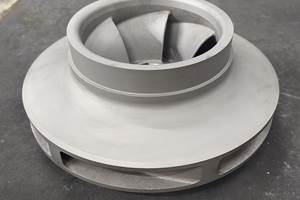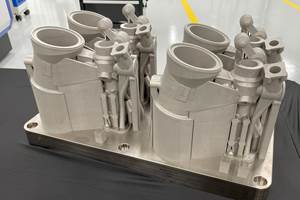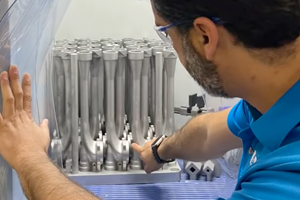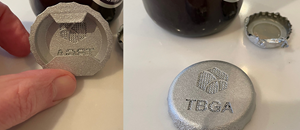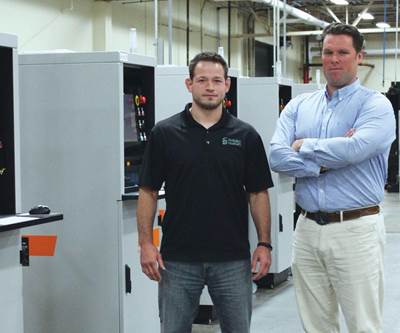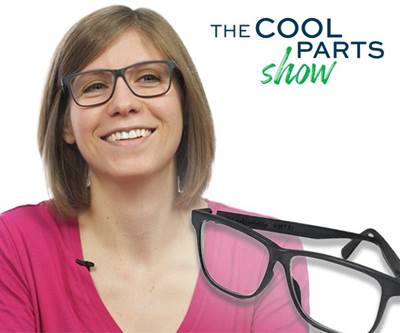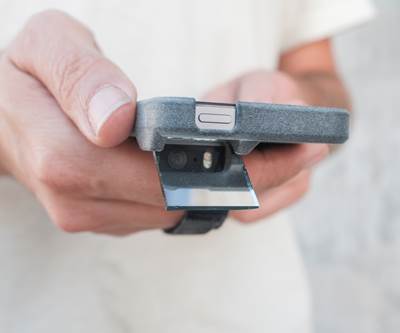3D printing as a production method solves many of the barriers to entry found in conventional manufacturing. Metal 3D printing can deliver near-net shape forms, setting a manufacturer free of castings and the tooling they require. Likewise, polymer 3D printing allows for the direct creation of a plastic part, with no need for an injection mold. The avoidance of tooling translates to benefits such as faster lead times, reduced cost and greater freedom in design as well, which in turn can enable possibilities such as mass customization. (This is the case for Retraction Footwear, provider of the photo at the top of this page and manufacturer of custom, on-demand flip-flops.) For an inventor or a company becoming a manufacturer without incumbent processes, 3D printing can seem like the natural, obvious choice.
But what is the nature of the relationship between additive manufacturing and startups? Does AM drive startups, or is it driven by startups? Where do technology suppliers fall? Peter Zelinski, Julia Hider and I discuss this on the most recent episode of the AM Radio podcast. Listen above, or read on for the transcript and notes.
Transcript
Julia Hider
The AM Radio podcast is brought to you by the Additive Manufacturing Conference and Expo, the leading industry event focused on 3D printing for production. The conference takes a practical applications-based look at the machines, materials and methodologies being used to create and use tools and components. The event is designed for owners, executives and engineers, as well as OEMs involved in durable goods manufacturing. Join the Additive Manufacturing team in Cincinnati, Ohio, for two days of in-depth conference sessions, exhibits and networking opportunities with AM experts. Also on the expo floor, check out the finalist entries on The Cool Parts Showcase, a contest to find the next subjects of our video series. The Cool Parts Show, be sure to vote on your favorite. The Additive Manufacturing Conference and Expo runs October 12 through 14th. Find out more details and register at AdditiveConference.com.
Peter Zelinski
We were just having a conversation about additive manufacturing and the way that it’s different from other manufacturing processes, including some ways it’s kind of fundamentally and conceptually different from, from other established approaches to manufacturing. And related to that, we’re seeing how additive manufacturing is enabling different types of manufacturers, different types of businesses. I think we’ve seen quite a number of examples of that — startups in the industrial 3D printing space, startups made possible because of 3D printing. Stephanie, rattle off a few examples off the top of your head, companies that come to mind that are examples of this.
Stephanie Hendrixson
Okay, well, I knew we were going to talk about this. So I came prepared. But some examples of startups that we’ve seen, and I think we’re defining startups as companies that are being kind of built around 3D printing. And a lot of these were founded by people, not from a manufacturing background. So examples — Fitz Frames makes custom glasses. Node Audio is this company that was developed around a really innovative speaker housing design. And they’re making that with 3D printing. Retraction Footwear, which is a company in Australia that makes custom flip flops. The Future of Jewelry, which actually, they’re using the 3D printing for tooling, but it’s the key to their custom jewelry business. Tilt Hydrometer is a company founded by a guy who is a home brewer, and he had this idea for a device that would help home brewers in making their beer. And it turned into a whole product and a whole company. And the key part of this product is 3D printed. Another one would be Defox, which makes a specialized phone case. And then the one that we keep going back to over and over is this company called Tangible Solutions, which was completely built around metal 3D printing for implants.
Peter Zelinski
So in that list, again, you went out on a particularly high value product medical implants, like, so there’s a huge range in there. There’s, there’s some pretty simple consumer products into, into sort of, like, life changing medical implant technology being made by startups being made through 3D printing. Like, why is this happening? I’m actually really excited about this. And I don’t want to jump all over and answer my own question, but like, why is this happening? I want to talk about this.
Julia Hider
Yeah, I think, you know, Stephanie listed a whole bunch of companies. And I think the reasons are as varied as the companies. Sometimes they’re making a product that physically can’t be made any other way. And sometimes they, you know, they don’t want to invest in tooling, or they can’t invest in tooling at that point. And mass customization is another one too.
Peter Zelinski
Let me jump in on the tooling one, like I think we, I don’t think we appreciate how huge it is — the arrival and development of this tooling free manufacturing option. We take it for granted in manufacturing. The tooling just shapes, and defines, and limits and constrains everything we might do, including what minimum quantities are possible. We’re talking about these startup companies. And if you’ve got an idea, with additive manufacturing, like all of a sudden, it’s possible to enter the market with a much smaller initial manufacturing run that would ever have been possible before.
Stephanie Hendrixson
Yeah, so just like thinking back through that list, like Defox is a great example. They develop the, that Periscope phone case. And it’s, like, a really kind of niche-y product; it’s not something that everybody needs, or everybody would want. And if you were just the inventor of a product like that a phone case and you wanted to get it made, you would have to make that investment in tooling, you’d need an injection mold. And if you want to offer it for more than one phone model, you’re going to need multiple tools, multiple mold, molds, it’s going to get very, very expensive. So in their case, like the natural thing to do, coming from, you know, not a place of having all the resources to, to buy a mold or to make a mold, the natural thing to do is to find someone who can 3D print the design that you have. And then it doesn’t matter how many phone cases they sell or how many phone cases that they need, they can order them as they need them. They can change the design as the phones change. And they’re not, like, locked into this really expensive tooling and this one style of product.
Peter Zelinski
Does 3D printing drive startups or are startups driving 3D printing?
Stephanie Hendrixson
So that’s an interesting question. I would argue that lots of companies are driving 3D printing, like we’ve seen this happen where a particular manufacturer has a specific need, and they go to their printer supplier, and they say, “I need this feature, can you can you add this? Or can you open up this option to me?” Or, “I need this particular type of material, can you develop that with me?” So I think that it’s not limited to startups, the way that that 3D printing is being driven forward. And I don’t think I’d say that 3D printing drives startups. I think I would say that it enables startups. If you have a great product idea, but you don’t have the capital, or it’s not something that makes a lot of sense for it to be injection molded, and you’re coming at this kind of from outside the industry, like yeah, 3D printing is the natural thing you would go towards. It’s not as restrictive as injection molding or some of these other processes. And it actually, like, it makes a lot of sense. And I think that’s why so many startups gravitate towards it.
Peter Zelinski
So I think the fascinating thing to me enabling startups, but enabling manufacturers, enabling new entrants to manufacturing. And additive is absolutely doing that. An inventor can become a manufacturer, and that is this really fascinating phenomenon. I think we’re seeing so much of your list of examples. You mentioned, you mentioned Fitz Frames, like that they come right to mind as a company — had a great idea, never intended to be a manufacturer, but discovered that through 3D printing, they could make their own product according to their own design according to their own vision. And that’s sort of, that’s the really exciting thing about this is that we don’t know who the manufacturers are going to be tomorrow. And some of the innovators out there don’t realize yet they’re on their way to being manufacturers because they're going to realize that 3D printing technology gives them a pretty accessible entree into just making their own style.
Stephanie Hendrixson
Yeah, so just running back through that list that I’m looking at, like these companies were founded by industrial designers, a civil engineer, a couple of lawyers, a home brewer. Like, these are not necessarily people with a manufacturing background, or even an engineering background, that are, nonetheless, able to become the manufacturers of a product through this technology.
Julia Hider
So, I kind of want to add something to this conversation because all of the startups we’ve talked about so far have been manufacturers, but there are a lot of startups on the supplier side as well. You know, you said that we don’t know who the manufacturers are going to be, you know, as Additive Manufacturing Media, we don’t always know who our advertisers are going to be in a few years. And I think that’s something that’s unique in additive manufacturing as well.
Peter Zelinski
That’s totally true. The technology is being driven and advanced, oftentimes by very young, very new companies. The advertisers thing. Yeah. So like, yeah, we’re media company. We live off of, of advertising. And there are, there are companies we have great relationships with today, that maybe three years ago, we never heard of because they were brand new or just coming out of stealth mode.
Stephanie Hendrixson
That’s so true. And that’s one of the things I really like about this space, like walking into a trade show knowing I’m going to meet people and, and learn about companies and technologies that I’ve never seen before, that I’ve never heard of. And I think that’s why additive manufacturing is such an exciting place to be both for the people who are using it, the people that are making it and then the people like us who get to report on it and follow it.
So I think that’s it for this episode of AM Radio. If you like the show, leave us a rating. Reach out. Let us know. Subscribe wherever you get podcasts and tell a friend.
Julia Hider
And if you want to learn more about any of the companies we mentioned in this episode, we’ll have links to articles about all of them in the show notes.
Peter Zelinski
AM Radio is recorded with help from Austin Grogan and Kade Nicholson. The show is edited by Stephanie Hendrixson and Alex Lytle. Our artwork is by Kate Billberry. AM Radio and Additive Manufacturing Media are products of Gardner Business Media, located in Cincinnati, Ohio.
Learn more at additivemanufacturing.media.
Related Content
Four Ways This Additive Manufacturer Counters Risk Aversion
3D printing service bureau Objectify Technologies uses four globally-applicable strategies to help potential and current customers overcome the barriers to additive manufacturing adoption.
Read MoreWhy AM Leads to Internal Production for Collins Aerospace (Includes Video)
A new Charlotte-area center will provide additive manufacturing expertise and production capacity for Collins business units based across the country, allowing the company to guard proprietary design and process details that are often part of AM.
Read More5 Big Themes in Additive Manufacturing at Formnext Forum: Austin
Formnext Forum: Austin, a two-day event at the end of August focused on additive manufacturing for production, includes a conference exploring important ideas in AM related to supply chains, bridge production, enterprise transformation and more.
Read MoreA Framework for Qualifying Additively Manufactured Parts
A framework developed by The Barnes Global Advisors illustrates considerations and steps for qualifying additively manufactured parts, using an example familiar to those in AM: the 3D printed bottle opener.
Read MoreRead Next
Building an Additive Manufacturing Business for Production
What does it look like to build a business based on AM production from the ground up? An Ohio medical device contractor is finding out.
Read More3D Printed Custom Glasses: The Cool Parts Show #8
Fitz Frames has reimagined glasses, from the frames to the ordering process. See how the company manufactures glasses customized to every face in this episode of The Cool Parts Show.
Read MoreNiche Manufacturer Discovers How Additive and Amazon Go Together
The economics of 3D printing allow for cost-effective production of niche products, and Amazon Prime offers a way to distribute them. The Periscope Case is one company’s first venture into an all-new model aimed at bringing products to market that would never have been profitable before.
Read More

.jpg;width=70;height=70;mode=crop)







.png;maxWidth=300;quality=90)







